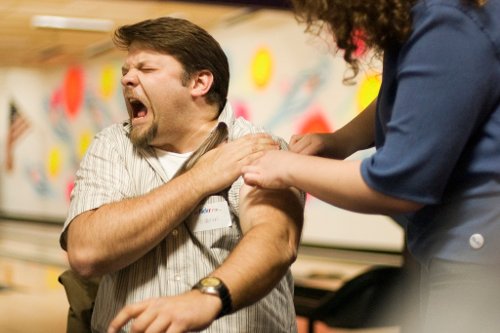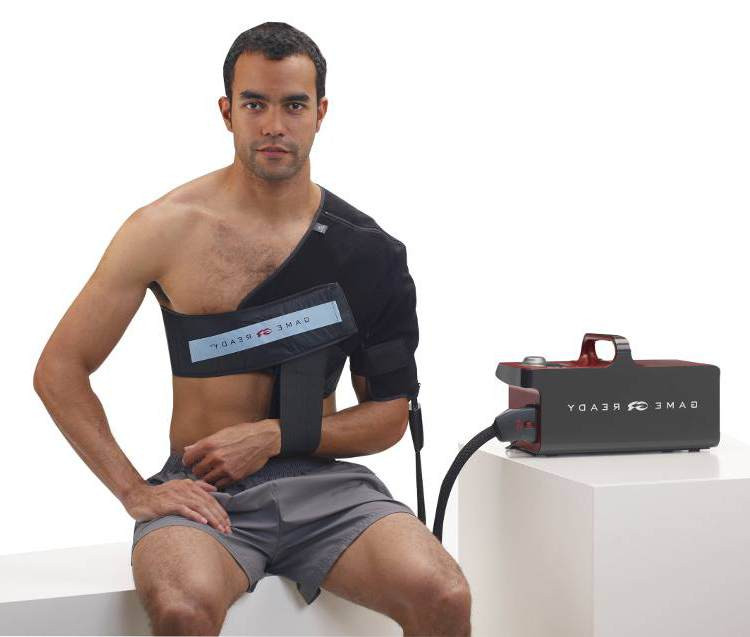 2nd Feb 2017
2nd Feb 2017
The Best Modalities for Radiating Shoulder Pain
Physical Therapy Combinations for Reducing Pain and Symptoms

It can happen at any time, sometimes without cause. A patient can begin experiencing radiating nerve pain that seems to originate in the neck, but runs all the way down the shoulder, arm, forearm, and even into the hand. This pain can be accompanied by other neurologic deficits such as numbness or weakness. Shoulder pain can cause debilitating problems for patients including:
- Loss of range of motion
- Difficulty performing daily living and work tasks
- Trouble sleeping
- Difficulty turning the head with radiating pain
And while sometimes the cause is unknown, shoulder pain can be caused by:
- Herniated disks
- Bone spurs
- Pinched nerves
- Tumor or infection
- Shoulder Dislocation
With this broad range of symptoms, cervical radiculopathy requires a combination of treatment modalities in order to address all issues.
Physical Therapy Modalities to Treat Symptoms Associated with Shoulder Pain
- Cold Compression Therapy: Cold compression therapy with its available neck wrap is a great modality to use to treat acute pain caused by shoulder pain. In addition, the compression offered by the device can help reduce swelling and inflammation of the area which might be causing pinched nerves and resulting pain.
- Therapeutic Ultrasound: Ultrasound therapy performed either before or after spinal traction is a popular combination when treating the pain associated with shoulder pain. Ultrasound therapy is able to reduce pain and inflammation, making it easier for patients to regain range of motion and movement, particularly to the neck and head.
- Electrical Stimulation: Another popular physical therapy treatment for shoulder pain, electrical stimulation machines work well to reduce pain either alone or simultaneously with ultrasound therapy. Additionally, there are transcutaneous electrical nerve stimulation devices that are designed for home use. These portable TENS units are great for patients who have chronic pain and are experiencing difficulty in having it resolve.
- LED Light Therapy: The dpl Flex Pad Pain relief system is another great example of a pain management treatment for shoulder pain that can be used either as part of physical therapy treatment or for the patient’s home use. With a wrap that can address radiating shoulder and neck pain, this is a great modality for reducing pain and improving range of motion in a short amount of treatment time.
- Traction table: A study of cervical radiculopathy and shoulder pain found that soft tissue mobilization positively helped to reduce pain and decrease pressure on an impinged nerve. Physical therapists can do this manually or with the help of a traction table. The Tx Traction unit helps to mobilize muscles, ligaments and joints that can decompress on the nerve roots and intervertebral disks. The traction unit has many therapeutic benefits:
- The ability to reduce disc pressure
- Relieves any nerve root compression
- Improves blood flow and circulation
- Relaxes spasming and tight muscles
There are many powerful modalities that can be used in physical therapy to treat shoulder pain and associated problems. While each patient’s case may be different, these modalities give practitioners the right combination of tools to return patients to full function.
Let’s look at a case study where physical therapy rehabilitation is necessary to treat shoulder pain.
Modalities & Treatment of Shoulder Dislocation
A 46-year old man suffers from a shoulder dislocation after playing football and sustaining a hard tackle. He presents with severe pain and instability in the joint. Recommended treatment is outlined below.

Dislocations heal in three phases and should include treatment that addresses the need for:
- Pain management
- Reduction in swelling and edema
- Re-strengthening of the shoulder
The three phases of rehabilitation after shoulder dislocation include specific needs in each phase including:
- Phase 1-Reduce pain and lessen swelling
- Phase 2-Improve range of motion
- Phase 3-Return to function in day to day activities
Rehab of the shoulder begins after the shoulder has been put back into place and consists of:
Phase 1 -The patient is given a polysling to minimize movement of the arm and shoulder. Pain and subsequent swelling can present a problem during this phase of rehabilitation. In addition to some gentle exercises intended to prevent stiffness, specific modalities will be used as part of the rehabilitation regimen for pain management.
- Cold Compression Therapy: Cold compression therapy is an excellent modality to use when choosing a non-invasive modality that can reduce both the pain and swelling a patient may experience as a result of a shoulder dislocation. Further, the easy to use cold compression device is perfect for patients to use on their own at home as an alternative to oral pain medication.
- Ultrasound therapy: A study published in the International Journal of Scientific and Research Publications found that ultrasound therapy treatment used in combination with gentle shoulder exercises showed greater improvement in range of motion and reduction in pain.
- Transcutaneous electrical nerve stimulation (TENS): TENS is another treatment modality that is a great choice for pain management. By blocking nerve impulses from the brain, TENS is able to quickly reduce acute pain associated with a dislocated shoulder. TENS is another pain management modality that can be offered as a portable device for patient’s home use. Read more: TENs Electrode Placement Guide.
- Heat therapy: Heat therapy in the form of hot packs, heating pad, whirlpool, etc. can also be used in physical therapy in order to reduce pain, decrease resulting stiffness and gently increase range of motion in dislocated shoulder patients.
These pain management modalities are primarily used in Phase 1 because that is the period of time with the most acute pain for dislocated shoulder patients. However, residual pain can occur as patients move through Phase2 and 3 of their physical therapy treatment, making these modalities safe pain management options throughout their recovery process.
Phase 2-The purpose of Phase 2 is to help a dislocated shoulder patient regain range of motion and strength while also re-establish muscle balance within the shoulder. Therapeutic exercise, gentle stretching and joint mobilization are added to pain and swelling management modalities.
Phase 3-Phase 3 is the working towards full function within daily activities, including exercise and sports regimens. Rehabilitation in this phases focuses on helping dislocated shoulder patients to regain neuromuscular control of their shoulder with exercises that strengthen and challenge the unstable shoulder.
Healing from a dislocated shoulder can take 12-16 weeks to completely recover and be able to fully return to day to day activities. 68% of shoulder dislocation patients are at risk for recurrence (Source). Seeking rehabilitation for shoulder dislocation improves not only recovery time, but helps lower the risk for future shoulder problems and possible recurrent dislocation.
For more information about chronic pain and the physical therapy modalities used to treat it please head over to the ProHealthcareProducts.com Blog.






